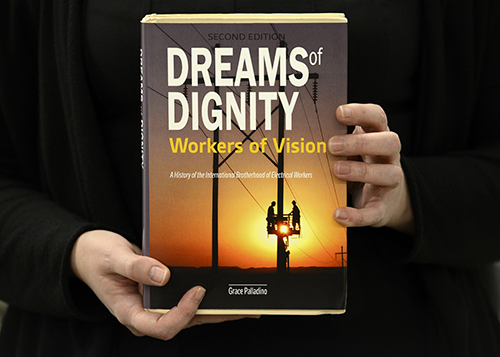Just in time for its 125th anniversary, the IBEW is issuing an update of the book that commemorated its 100th anniversary.

|
| “Dreams of Dignity, Workers of Vision” has been updated with three new chapters covering the last 25 years of IBEW history. The new edition will be available at the upcoming International Convention.
|
“Dreams of Dignity, Workers of Vision” is being reissued with three additional chapters by author Grace Palladino that examine the last 25 years of IBEW history. The new edition will be distributed to delegates at the International Convention in St. Louis in September. It will be available for purchase online at the IBEW Store.
Palladino, a labor historian and editor of the Samuel Gompers Papers Project at the University of Maryland before retiring in 2011, also wrote the original version of the IBEW’s history in 1991.
“I tried to write it in a way that the rank-and-file members can read it and understand all the decisions that have been made,” she said. “One of the nicest things is when I get an email from one of them saying, ‘Thanks for doing this. I learned a lot.’ As a historian, that’s what you want.”
The book covers significant changes in the IBEW during the last 25 years, including:
- The implementation of the Code of Excellence – and the events that led to it – in 2007. The Code has since become a cornerstone of the IBEW, symbolizing the members’ commitment to safety and quality.
- Initiatives to increase participation by younger workers, most notably the formation of RENEW/NextGen in 2011. RENEW encourages members 35 and younger to get more involved in their locals by focusing on issues important to them and provides leadership training.
- Moves to enhance organizing efforts during the last 25 years as the IBEW worked to maintain its declining market share in an environment increasingly hostile to labor.
- The introduction of alternate job classifications, designed to help make IBEW signatory contractors more competitive by allowing greater flexibility in crew mixes and aid in organizing.
- The economic collapse in 2008 and its effects, including widespread unemployment and how it slowed IBEW initiatives in organizing.
IBEW Media Director Mark Brueggenjohann, who worked with Palladino on the updated edition, said the book will give members a better understanding into what went into policy shifts that many of them remember.
“It’s a much more modern union than it was 25 years ago,” Brueggenjohann said. “I think the new section of the book really lays out how those changes came about and who was instrumental in making those changes and that it didn’t come easy. There was a little bit of a struggle.”
“Grace did dozens of interviews and she talked to the people that were there and were making the decisions,” he added. “The other thing I like is she isn’t sugarcoating anything. She looked at it as a historian. The good and the bad are all there.”
Palladino said the book reminds workers the IBEW still gives electricians, linemen and members in its other sectors a chance at a better life.
“Considering what it has to offer,” she said, “you’re better off joining a union.”
The book includes extensive writing on the founding of the Brotherhood by Henry Miller in 1891; the Reid-Murphy split in 1908 that lasted five years and nearly destroyed the IBEW; and the post-World War II boom in construction that fueled its growth.
The 39th IBEW International Convention opens on Sept. 19, and IBEW.org will cover pre-convention events starting Sept. 15 and running through the closing gavel on Sept. 23.